- Revenue Cycle Management
- COVID-19
- Reimbursement
- Diabetes Awareness Month
- Risk Management
- Patient Retention
- Staffing
- Medical Economics® 100th Anniversary
- Coding and documentation
- Business of Endocrinology
- Telehealth
- Physicians Financial News
- Cybersecurity
- Cardiovascular Clinical Consult
- Locum Tenens, brought to you by LocumLife®
- Weight Management
- Business of Women's Health
- Practice Efficiency
- Finance and Wealth
- EHRs
- Remote Patient Monitoring
- Sponsored Webinars
- Medical Technology
- Billing and collections
- Acute Pain Management
- Exclusive Content
- Value-based Care
- Business of Pediatrics
- Concierge Medicine 2.0 by Castle Connolly Private Health Partners
- Practice Growth
- Concierge Medicine
- Business of Cardiology
- Implementing the Topcon Ocular Telehealth Platform
- Malpractice
- Influenza
- Sexual Health
- Chronic Conditions
- Technology
- Legal and Policy
- Money
- Opinion
- Vaccines
- Practice Management
- Patient Relations
- Careers
Poland: Travel Imagined for More Than 70 Years
A trip through Poland brings memories of a painful past, but also the inspiration of a people who could not be broken.
In the early 1990s some elderly Polish patients found their way to my geriatrics practice in San Diego through the maze of their health plan. They were an amiable group accompanied by a young niece who was bilingual. She explained she would help translate. “Oh,” I said, tongue in cheek, “I speak some Polish,” and continued with “Nie mamy papierosow.”
One of the younger women around the old lady in the wheel chair produced a packet of cigarettes from her purse and shook one out at me. I turned awkwardly to my interpreter and raised my eyebrows. “You have just said ‘You have no cigarettes,’” she explained.
I stumbled into my story: As an 8-year-old child in a small town, Crieff, in the flank of the Scottish Highlands in late 1940, I was helping my parents who had a tobacco counter in the entrance to their restaurant. They needed my help. The town and their shop had become busy as the Free Polish military in exile had arrived to train in Scottish remote areas as part of Britain’s defense against Hitler’s expected invasion. It took time for the Polish soldiers to realize tobacco supplies arrived at the shops on Mondays and if they wanted cigarettes they shouldn’t wait till Tuesdays.
A Polish officer tells me. “We Poles are busy. Spieszymy sie. We are in a hurry to fight Germans. We don’t want to stand here idle and hear you offer, ‘It’s a nice day.’ Mamy dzisiaj piekny dzien. We’d rather you immediately tell us Nie mamy papierosow ‘We have no cigarettes’ and we will be on our way.”
I write down the phonetic pronunciation on a scrap of paper. I memorize the three phrases and — finally – 75 years later telephone the USA Director of Polska, the Polish National Tourist Office in Frank Sinatra’s home town, Hoboken, NJ to get the spelling and know which phrase is which.
“Move Your Imagination,” says Polska’s logo.
I move mine back to the frightening events of World War II and images of parents bowed before the “wireless” (radio) speaker, a hand raised interminably to my brother John and me that signals “DO NOT SPEAK.” I recall the newspaper headlines as first Europe then the world collapsed. Even then as a small boy I realize how much worse it must be for Poles living free in exile, the only foreigners I’d ever met in my long eight years.
I took a personal pride in my Polish customers when my father told me the Poles hated the Nazis so much that the experienced pilots who had escaped from Poland and were recruited for Royal Air Force Fighter Command in the Battle of Britain that terrible year in 1940 had to be begged not to crash their Hurricanes into German bombers if they ran out of ammunition.

I find later in Warsaw’s Palace of Culture and Science, the monstrosity the Soviets built during their occupation, that Poland had a role in the early days of aviation and even today communities still stage flying shows. “The Palace was called ‘Stalin’s Gift to Poland,’” a guide tells us, “But it wasn’t free. We paid for it with 50 years of communism.”
Historians believe the Battle of Britain was the most important event in World War II because if Hitler had obtained air supremacy he was ready to launch his “Operation Sea Lion” invasion.
“We can replace lost airplanes but not our pilots,” the RAF Air Chief Marshal reportedly told his Polish pilots. After the War, the Polish 303 Squadron was recognized as the most successful Fighter Command unit in the Battle of Britain. And in the allied defeat in the poorly conceived Battle of Arnhem (where 42,000 allied airborne troops were dropped, unfortunately, on top of two resting German tank divisions) it was General Sosabowski’s Polish 1st Independent Parachute Brigade who covered the retreat of the remnants of the British 1st Airborne Division even though Polish losses themselves approached 40%. We have written about Arnhem elsewhere (click here) yet noticed this terrible battle still produced 11 Virtuti Militari, the highest Polish award for heroic services in battle.
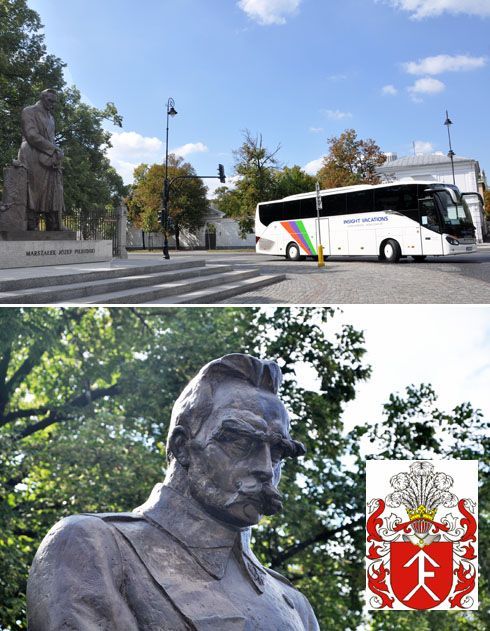
When our coach tour ends in Warsaw, Poland’s capital, we find out more about Poland’s heroes. Our local guide tells us she has three favorite Poles who all achieved greatness, and — she tells us – “they all had large mustaches. This is Mustache Number 1, Marszalek Jozef Pilsudski.” She mentions the other two but explains, “I do not include our beloved Polish Pope John Paul II in those three because he did not have a mustache!”
Long proud that little Britain declared war on Germany because it had attacked Poland, I was dismayed to read in William Manchester’s definitive nonfiction book on Winston Churchill The Last Lion (which covered the years from 1930 to 1940) evidence that both France and Britain dragged their heels and took an unbelievable four days to honor their promise to Poland.
Poland was arguably the bravest country to oppose Nazi Germany — and, the home of 80% of the Jews in Europe, it lost more of its population than any other land. The only forces that could repel Hitler, given Stalin was now by his side, were the armies of Britain and France. Historians now suggest His Majesty’s Government (with the “warmonger” Churchill exiled as a back bencher) was incompetent, inattentive and, worse, pro-German, whereas France’s army, larger than Germany’s, was badly led and its government cowardly.
Poland has a population of 38 million, about equal to California. Its size is the same as New Mexico. It is a flat plain and has been throughout history a corridor for invading armies. Its flag is white and red: white for Honor and red for Blood which just about sums up its history. Its flag once also bore Poland’s coat of arms, a crowned eagle, but the communist regime removed the crown and actually cropped the eagle’s talons.
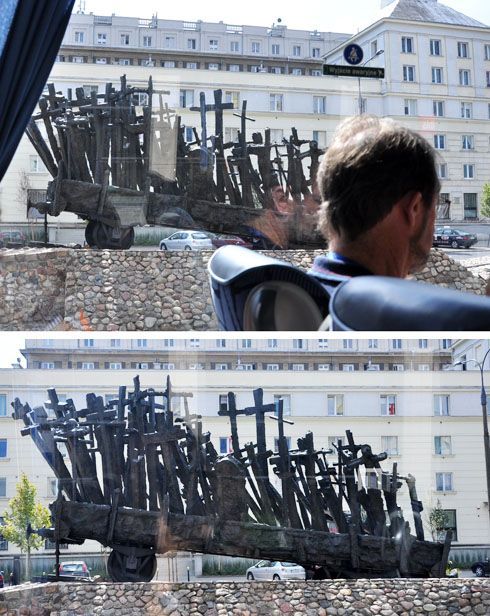
Our coach passes a Monument to Those Killed and Murdered in the East: an open rail car filled with a pile of rails with crosses memorializing Poles who were expelled to labor camps in Siberia and never came back, and to those 22,000 military officers and Polish intelligentsia murdered by the Soviets in the appalling Katyn Massacre in the Forest near Smolensk.
Poland has a very strong Catholic base which was the basis for the communist regime’s ultimate failure to impose its system on the people. Stalin once famously said introducing communism to Poland was “like putting a saddle on a cow.” Even under communism, the people did not break; they would even whisper to each other, “Have you heard about the new government-sponsored prize for the funniest political joke? It’s 15 years in prison.”
So when I found the tour operator who gave us such a satisfactory experience in Spain about two years ago (see our Insight Vacations) had a somewhat similar detailed excursion around Poland, my question was not would the trip be worth taking but, as an ex-Brit would the people I met in Poland forgive my original country for the history we share.
It was a history that surely no country should ever have to suffer. Some, including Adam Mickiewicz, have called Poland the martyr of Europe, “the Christ of Nations,” suggesting when Poland was partitioned by belligerent neighbors in the 19th century, the persecution of the Poles would bring salvation to other persecuted nations and “redemption to mankind.”
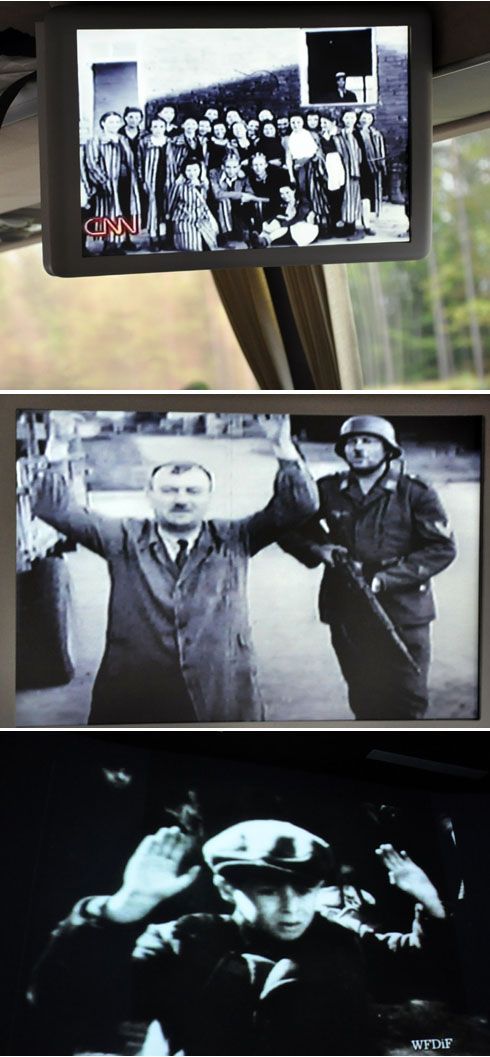
In the coach, our tour manager Piotr projects images on the screens of painful moments in 20th century history, images of concentration camp inmates and Polish citizens and children raising their hands to an armed German soldier.
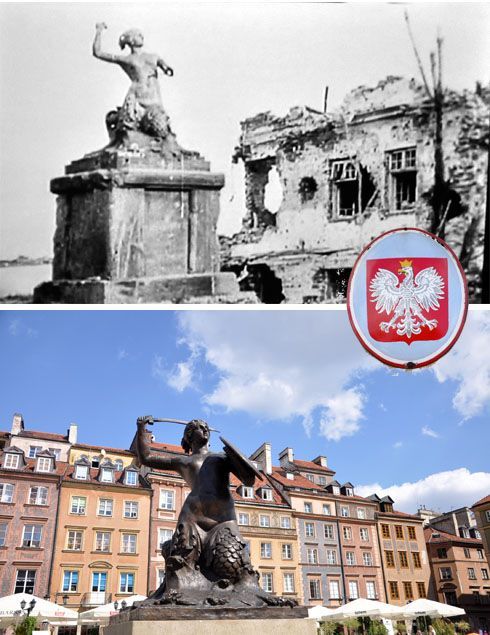
We see a documentary movie in Warsaw’s restored Old Town. It shows the devastation when the Germans destroyed Warsaw even as the Russian army, now a German enemy, sat silent across the river although it could have prevented the destruction. We compare the black and white image then with our colored image taken that day.

And we compared the scene of the devastation of Warsaw with our current images. What nation could stand firm and endure such desolation? What could possibly allow a broken land like this to recover? The answer: Polish pride. Resilience of a people who have never had it easy. The spirit, the courage of a people whose army in 1939 (imagine it!) charged the German panzer tanks with its mounted World War I cavalry.
British author A.N. Wilson once declared “History does not eliminate grievances. It lays them down like landmines.” Today’s reality is the Poles have suffered too much in the last 100 years to collapse in the fetal position and let the world pass them by. They are a strong irrepressible people who have had to endure the armies of their belligerent neighbors in all their military sturm und drang for a very long time The Poles are too busy today clarifying their future to be sulking or crying about their past.
And yet once we get there we will be engulfed in that past. Fortunately the Insight Vacations coach trip begins in Krakow, the ancient capital city. The Nazis used it as their headquarters in Poland so they did not damage it much in World War II. We “bookended” the tour with additional days in Krakow at the beginning and with extra time in Warsaw at the end. We had an idea what we’d see first in those two cities. And knew how much we wanted to talk to Poles.
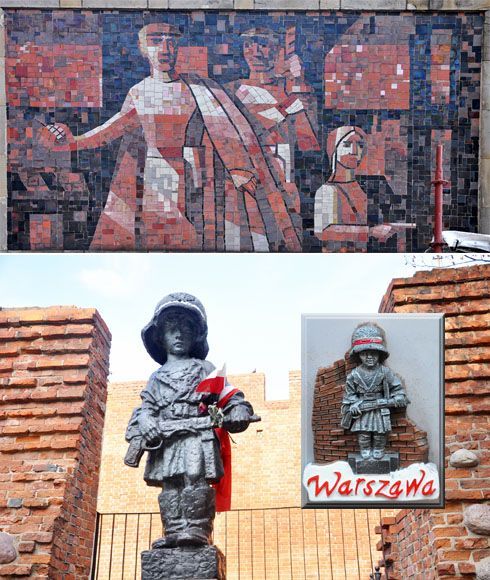
We walk in Warsaw past a mural of brick art that shows the Polish people rising against oppression. We pass the bronze statue of the Little Insurgent by Jerzy Jarnuszkiewicz which pays tribute to the children who worked as messengers during the 1944 Warsaw Uprising. He is clutching a Sten gun but our guide takes care to explain that their role was getting messages fast to Polish combatants not firing guns.
I think about how a country can be broken but not its people.
I think of Polish pride and what Poles have been through.
I think how pleased the little group of Polish patients was when they found I could speak some Polish and how complicated it became one day when the group came without their niece, their interpreter who had gone on vacation to Las Vegas.
And as I, a non-smoker but aware of the generosity of the Poles, walked through Warsaw with Nancy at the end of a long day I wished I knew not “Nie mamy papierosow,” but the Polish for “I have no chocolate.”
Photography by the author
The Andersons, who live in San Diego, are the resident travel & cruise columnists for Physician's Money Digest. Nancy is a former nursing educator, Eric a retired MD. The one-time president of the New Hampshire Academy of Family Physicians, Eric is the only physician in the Society of American Travel Writers. He has also written five books, the last called The Man Who Cried Orange: Stories from a Doctor's Life.
